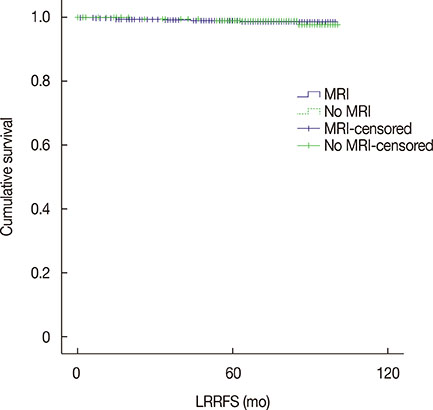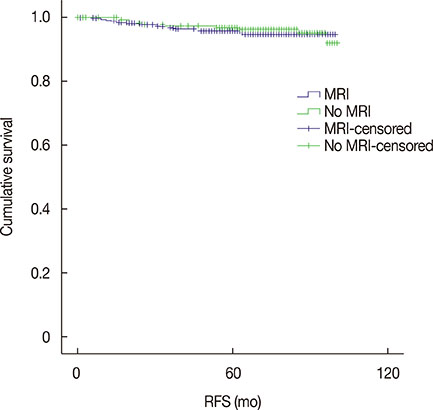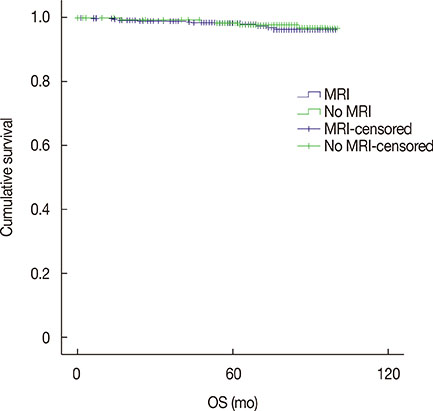J Breast Cancer.
2016 Dec;19(4):423-428. 10.4048/jbc.2016.19.4.423.
Preoperative Magnetic Resonance Imaging and Survival Outcomes in T1–2 Breast Cancer Patients Who Receive Breast-Conserving Therapy
- Affiliations
-
- 1Department of Surgery, Yonsei University College of Medicine, Seoul, Korea. skim@yuhs.ac
- KMID: 2362929
- DOI: http://doi.org/10.4048/jbc.2016.19.4.423
Abstract
- PURPOSE
The purpose of the study was to evaluate the effect of preoperative magnetic resonance imaging (MRI) on survival outcomes for breast cancer.
METHODS
A total of 954 patients who had T1-2 breast cancer and received breast-conserving therapy (BCT) between 2007 and 2010 were enrolled. We divided the patients according to whether they received preoperative MRI or not. Survival outcomes, including locoregional recurrence-free survival (LRRFS), recurrence-free survival (RFS), and overall survival (OS), were analyzed.
RESULTS
Preoperative MRI was performed in 743 of 954 patients. Clinicopathological features were not significantly different between patients with and without preoperative MRI. In the univariate analyses, larger tumors were marginally associated with poor LRRFS compared to smaller tumors (hazard ratio [HR], 3.22; p=0.053). Tumor size, histologic grade, estrogen receptor (ER), progesterone receptor (PR), hormonal therapy, and adjuvant chemotherapy status were associated with RFS. Larger tumor size, higher histologic grade, lack of ER and PR expression, and no hormonal therapy were associated with decreased OS. Tumor size was associated with LRRFS in the multivariate analyses (HR, 4.19; p=0.048). However, preoperative MRI was not significantly associated with LRRFS, RFS, or OS in either univariate or multivariate analyses.
CONCLUSION
Preoperative MRI did not influence survival outcomes in T1-2 breast cancer patients who underwent BCT. Routine use of preoperative MRI in T1-2 breast cancer may not translate into longer RFS and OS.
MeSH Terms
Figure
Reference
-
1. Fisher B, Redmond C, Poisson R, Margolese R, Wolmark N, Wickerham L, et al. Eight-year results of a randomized clinical trial comparing total mastectomy and lumpectomy with or without irradiation in the treatment of breast cancer. N Engl J Med. 1989; 320:822–828.
Article2. Veronesi U, Saccozzi R, Del Vecchio M, Banfi A, Clemente C, De Lena M, et al. Comparing radical mastectomy with quadrantectomy, axillary dissection, and radiotherapy in patients with small cancers of the breast. N Engl J Med. 1981; 305:6–11.
Article3. Lagios MD. Multicentricity of breast carcinoma demonstrated by routine correlated serial subgross and radiographic examination. Cancer. 1977; 40:1726–1734.
Article4. Douek M, Vaidya JS, Baum M, Taylor I. Magnetic-resonance imaging and breast cancer multicentricity. Lancet. 1998; 352:652–653.
Article5. Egan RL. Multicentric breast carcinomas: clinical-radiographic-pathologic whole organ studies and 10-year survival. Cancer. 1982; 49:1123–1130.
Article6. Yerushalmi R, Kennecke H, Woods R, Olivotto IA, Speers C, Gelmon KA. Does multicentric/multifocal breast cancer differ from unifocal breast cancer? An analysis of survival and contralateral breast cancer incidence. Breast Cancer Res Treat. 2009; 117:365–370.
Article7. Kopans DB, Meyer JE, Sadowsky N. Breast imaging. N Engl J Med. 1984; 310:960–967.
Article8. Kuhl CK, Schrading S, Leutner CC, Morakkabati-Spitz N, Wardelmann E, Fimmers R, et al. Mammography, breast ultrasound, and magnetic resonance imaging for surveillance of women at high familial risk for breast cancer. J Clin Oncol. 2005; 23:8469–8476.
Article9. Saslow D, Boetes C, Burke W, Harms S, Leach MO, Lehman CD, et al. American Cancer Society guidelines for breast screening with MRI as an adjunct to mammography. CA Cancer J Clin. 2007; 57:75–89.
Article10. Berg WA, Gutierrez L, NessAiver MS, Carter WB, Bhargavan M, Lewis RS, et al. Diagnostic accuracy of mammography, clinical examination, US, and MR imaging in preoperative assessment of breast cancer. Radiology. 2004; 233:830–849.
Article11. Barchie MF, Clive KS, Tyler JA, Sutcliffe JB, Kirkpatrick AD, Bell LM, et al. Standardized pretreatment breast MRI: accuracy and influence on mastectomy decisions. J Surg Oncol. 2011; 104:741–745.
Article12. Sung JS, Li J, Da Costa G, Patil S, Van Zee KJ, Dershaw DD, et al. Preoperative breast MRI for early-stage breast cancer: effect on surgical and long-term outcomes. AJR Am J Roentgenol. 2014; 202:1376–1382.
Article13. Pilewskie M, Olcese C, Eaton A, Patil S, Morris E, Morrow M, et al. Perioperative breast MRI is not associated with lower locoregional recurrence rates in DCIS patients treated with or without radiation. Ann Surg Oncol. 2014; 21:1552–1560.
Article14. Bleicher RJ, Ciocca RM, Egleston BL, Sesa L, Evers K, Sigurdson ER, et al. Association of routine pretreatment magnetic resonance imaging with time to surgery, mastectomy rate, and margin status. J Am Coll Surg. 2009; 209:180–187.
Article15. Brennan ME, Houssami N, Lord S, Macaskill P, Irwig L, Dixon JM, et al. Magnetic resonance imaging screening of the contralateral breast in women with newly diagnosed breast cancer: systematic review and meta-analysis of incremental cancer detection and impact on surgical management. J Clin Oncol. 2009; 27:5640–5649.
Article16. Clinical practice guidelines in oncology (NCCN guidelines) breast cancer screening and diagnosis. National Comprehensive Cancer Network;2013. Accessed July 13th. 2014. http://www.nccn.org/professionals/physician_gls/f_guidelines.asp.17. Breast cancer treatment guideline. Korean Breast Cancer Society;2015. Accessed July 13th. 2014. http://www.kbcs.or.kr/journal/file/d_5_05.pdf.18. Greene FL, Page DL, Fleming ID, Fritz AG, Balch CM, Haller DG, et al. AJCC Cancer Staging Manual. 6th ed. New York: Springer;2002.19. Park HS, Park S, Kim JH, Lee JH, Choi SY, Park BW, et al. Clinicopathologic features and outcomes of metaplastic breast carcinoma: comparison with invasive ductal carcinoma of the breast. Yonsei Med J. 2010; 51:864–869.
Article20. Cho JH, Park JM, Park HS, Park S, Kim SI, Park BW. Oncologic safety of breast-conserving surgery compared to mastectomy in patients receiving neoadjuvant chemotherapy for locally advanced breast cancer. J Surg Oncol. 2013; 108:531–536.
Article21. Schnall MD, Blume J, Bluemke DA, Deangelis GA, Debruhl N, Harms S, et al. MRI detection of distinct incidental cancer in women with primary breast cancer studied in IBMC 6883. J Surg Oncol. 2005; 92:32–38.
Article22. Van Goethem M, Schelfout K, Dijckmans L, Van Der Auwera JC, Weyler J, Verslegers I, et al. MR mammography in the pre-operative staging of breast cancer in patients with dense breast tissue: comparison with mammography and ultrasound. Eur Radiol. 2004; 14:809–816.
Article23. Hlawatsch A, Teifke A, Schmidt M, Thelen M. Preoperative assessment of breast cancer: sonography versus MR imaging. AJR Am J Roentgenol. 2002; 179:1493–1501.
Article24. Turnbull L, Brown S, Harvey I, Olivier C, Drew P, Napp V, et al. Comparative effectiveness of MRI in breast cancer (COMICE) trial: a randomized controlled trial. Lancet. 2010; 375:563–571.
Article25. Peters NH, van Esser S, van den Bosch MA, Storm RK, Plaisier PW, van Dalen T, et al. Preoperative MRI and surgical management in patients with nonpalpable breast cancer: the MONET-randomised controlled trial. Eur J Cancer. 2011; 47:879–886.
Article26. Fischer U, Zachariae O, Baum F, von Heyden D, Funke M, Liersch T. The influence of preoperative MRI of the breasts on recurrence rate in patients with breast cancer. Eur Radiol. 2004; 14:1725–1731.
Article27. Solin LJ, Orel SG, Hwang WT, Harris EE, Schnall MD. Relationship of breast magnetic resonance imaging to outcome after breast-conservation treatment with radiation for women with early-stage invasive breast carcinoma or ductal carcinoma in situ. J Clin Oncol. 2008; 26:386–391.
Article
- Full Text Links
- Actions
-
Cited
- CITED
-
- Close
- Share
- Similar articles
-
- The Role of Preoperative Breast MRI in Patients With Early-Stage Breast Cancer
- Clinical Significance of Non-Mass-Like Enhancement of Preoperative Magnetic Resonance Imaging in Breast Cancer Considering Breast-Conserving Surgery
- The Role and Significance of Preoperative Breast MRI in the Setting of Breast Cancer
- Magnetic Resonance Findings of Breast Diseases
- A Rare Case of Male Primary Breast Lymphoma




